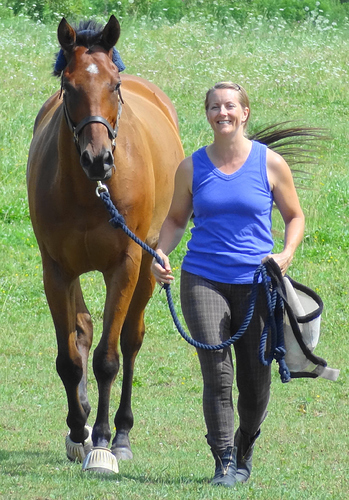Hello, I’m appealing to the wise folks of COTH today, as I’m extremely worried about my boy. He’ll be 17 in April. He is a TB gelding named Crosby that I’ve had since he was 3. I absolutely adore this horse. Words can’t express how much I love him. He has always been so sweet and kind and we’ve had many wonderful years together.
In February, he was diagnosed with a sinus infection. My vet referred us to a surgeon who recommended a sinus flush and it was booked for March 6th. It was to be a common, routine procedure done standing at the farm. When the surgeon attempted to insert the flushing tube through a small opening in Crosby’s skull (middle-left forehead), he encountered an unexpected mass of tough tissue. The Dr. then had to make a much larger opening in the skull, below the first one and fairly close to the left eye. At that point, needless to say, I was extremely shocked and worried. The surgeon then proceeded to start excising piece after piece of a large mass from Crosby’s sinus cavity. There was a lot of blood and I could barely watch. I’m usually not phased watching surgery, but this is my baby, so I was dying on the inside while trying to remain calm outwardly. Once the surgery was over, the sinus was packed with miles of gauze and the openings were sutured and bandaged and catheter placed for flushing. The bleeding subsided within the hour and the packing was removed.
Crosby’s after care involved daily flushing of the sinus cavity with 4L of saline for the first week and every 2nd day on week two. Dressing changes every other day, which involved bandaging his entire head. The poor guy handled everything like a champ, as always, and he seemed to heal up well. But, the nasal discharge he initially presented with came back in very short order.
Meanwhile, the tissue sample had been sent to the lab. The results came back a few weeks later stating that it was a fungal mass. Specifically, Alternaria sp. At that point, my vet said systemic antifungals were “not available” so we would just have to monitor and hope for the best.
Fast forward to now (September) and the discharge has not stopped and is getting increasingly worse. My vet consulted with 3 different surgeons, as she had never heard of this fungus before, let alone seen a case of it in equine sinuses. All surgeons agreed that the best and only course of action at this point is surgery AGAIN. I am so upset. I just can’t believe it. The first surgery was covered by insurance to the tune of $4,600 and this time I’m told it would be a minimum of $7,500 for the CT scan + surgery + systemic antifungals for weeks after, all which will NOT be covered by insurance as the issue is now disqualified from coverage.
They also stated that there is a “fair” chance that after all that, the infection/mass could still reoccur. The vet said that if I don’t opt for the surgery, all we can do is monitor the situation to ensure he is comfortable. He does not currently seem uncomfortable, but he is also very stoic, so how is one to really know for sure? She said that the infection can lead to headshaking syndrome and in rare cases can migrate to the brain.
I am devastated as now I feel like I am facing the unthinkable decision way before I ever thought I would. He’s only 16, but he has been through so much. He was hospitalized for 10 days a few years ago after contracting Strangles. He almost didn’t make it. A year later he had to have surgery for an ethmoid hematoma in the right sinus cavity and endured all that after care/recovery. Then the surgery for the fungal mass this past March and all that after care/recovery. Crosby has also been very arthritic in his hind end since he was about 8 years old. It is well managed and we think he is fairly comfortable since he gets around and up and down well, but he is not sound for anything but light hacking. He has navicular changes in both fronts too. This past month he had two abscesses in the same foot. It feels like I’ve been soaking and poulticing endlessly, but we’re finally winning on that front. I feel horrible for my sweet boy. It’s been an awful lot for him over the years.
So, all that to say I’m am really struggling with the idea of putting him through yet another surgery, considering the uncertain prognosis. I know fungi tend to be very resilient, so I’m extremely hesitant. Of course, if the prognosis was very good and he could likely have another 5 or 10 years of quality life, I wouldn’t hesitate, but that does not seem to be the case. I’m considering having just the CT scan done to see how fast the mass may be regrowing (if at all). I’m hoping maybe at that point the vets could give me some indication of his comfort level. I have always said I will never let him suffer; I will not hesitate to have him humanely euthanized if they think he is in unmanageable pain.
How would you proceed under these circumstances? Any suggestions, help or advice would be greatly appreciated. I have tried to search online for information, but there is not really much out there, as it is rare. There’s a fair bit about Alternaria sp. as a fungus, but not it’s effect on equine sinuses.
Thank you so much for reading all that and any help or advice you might be able to provide.



 ).
).
